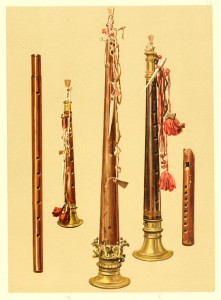PILLAGOVI. MUKAVINA. S’RUTI. NAGASARA. ALGOA.
THE three instruments in the centre of the plate belong to the same
class, and are in general use in all parts of India.
The Nagasara — the second from the right in the plate — is a reed
instrument with a conical bore enlarging downwards. It is usually pierced in
twelve holes, the upper seven of which alone are employed in fingering, the others
being stopped or otherwise with wax at the discretion of the performer, so as to
regulate the pitch of the instrument. The holes are bored at intervals roughly
corresponding to those of some Indian scale, but the native players often produce
other and additional intervals by allowing the fingers to only partially cover the
holes.
The Mukavina — the second from the left in the plate — bears a close
resemblance to the nagasara, but is usually much smaller, about half the size.
The flute to the left of the plate is the Pillagovi, or Murali, made of bamboo,
and traditionally believed to have been invented by the god Krishna, who is
usually represented as holding it or playing it. The name Bansuli is sometimes
given to this instrument.
The Algoa — shown on the right of the plate — is a kind of flageolet of
bamboo, with a tone and compass like that of the pillagovi. Instruments of
this kind are found in the Punjab and Upper India, played in pairs in a some-
what similar manner to the tibiae pares of the Romans.

